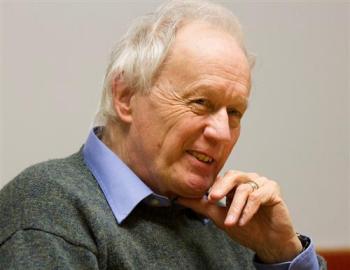Apr 2 2013
Why can’t time run backwards? In a lecture of that title that he gave here last week, Nobel laureate Sir Anthony J. Leggett explored some of the scientific, philosophical and even theological ramifications of the question.
 Every major revolution in physics in the last two millennia, Leggett said, has involved “the abandonment of a principle that had been regarded as the most basic and commonsensical.”
Every major revolution in physics in the last two millennia, Leggett said, has involved “the abandonment of a principle that had been regarded as the most basic and commonsensical.”
Leggett, who is renowned for his expertise in the theory of low-temperature physics, won the Nobel Prize for Physics in 2003 for his contributions to the theory of superconductors and superfluids. He shared the award with the Russian scientists Vitaly L. Ginzburg and Alexei A. Abrikosov.
Leggett visited Lehigh for two days last week at the invitation of the department of physics, the P.C. Rossin College of Engineering and Applied Science, and the College of Arts and Sciences.
Given his full schedule, Leggett might have wished to make time stand still if not actually reverse course. During his stay, he carved out time to give two lectures, to hold two lunch meetings with students, and to conduct 15 interviews with faculty members, exchanging ideas for half an hour at a time with one or two fellow scientists.
He leavened his lecture on time with humor, with lessons from history and with videos, including one film, shown forwards and then backwards, of two students walking down a set of steps into a classroom.
If only it were possible…
“We can remember the past and predict the future,” Leggett said, “not vice versa. How nice it would be if I could back to that party last weekend and correct my gaffe, or if I could go forward and see the outcome of a horse race, and then return to the present and place my bet accordingly!”
He noted that some scientists and philosophers, notably the French physicist Pierre LaPlace (1749-1827) have argued that the future cannot be affected.
“Take the example of a cannon firing a ball,” he said. “If we know the initial position of the cannon and the velocity at which the ball is fired, we can determine the ball’s exact trajectory. LaPlace, however, said you could also infer the ball’s complete trajectory from its final position and its velocity. He used this to argue that free will doesn’t exist.”
Leggett began his talk with this point: “At the very basic level, the laws of physics make no distinction between past and future…The fundamental microscopic laws of classical or quantum-mechanical physics look exactly the same if the direction of time is reversed.”
He listed the five “arrows of time” as thermodynamic, with entropy, or disorder, increasing over time; psychological—people remember the past and try to affect the future; biological—plants and animals grow; electromagnetic—stars and light bulbs emit radiation but do not absorb it; and cosmological—the universe is expanding over time.”
What a revolution entails
The most difficult issues in physics, Leggett said, “do not occur when we try to answer well-posed questions but, instead, when we don’t really know what question we’re trying to answer.”
Leggett, who spoke in the auditorium of Lewis Lab, stood still at this point, raised his arm and dropped it to his side.
“LaPlace would say that I didn’t voluntarily raise my arm,” he said. “Instead, he would say that the position of all the atoms in the universe caused me to raise it.”
Leggett concluded his lecture with a historical overview.
“Looking back over the history of physics, in the last 2,000 years, every real major revolution in our thinking has involved the abandonment of a principle that had been regarded as the most basic and commonsensical.
“That the past causes the present and the present causes the future, has never been challenged. But a revolution on the scale of quantum mechanics could change our ideas regarding the arrow of time.”
He offered a musical analogy.
“Louis Armstrong was once asked about the future of jazz. He responded, ‘If I knew where jazz was going, I would be there already.’”
Leggett is the John D. and Catherine T. MacArthur Professor and Center for Advanced Study Professor of Physics at the University of Illinois at Urbana-Champaign.
His discourse on time, delivered March 27, was the John J. Karakash Distinguished Lecture. The event is named for the late dean of the engineering college, who held that position from 1966 to 1981.
On March 28, Leggett gave the Frank J. Feigl Lecture in Physics, titled “Bell’s Theorem, Entanglement, Quantum Teleportation and all that.” The Feigl Lecture, established by the physics department, honors the memory of Feigl, who served 21 years on the department’s faculty until his death in 1988.